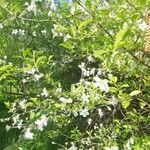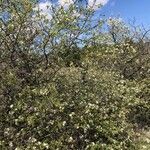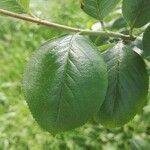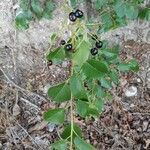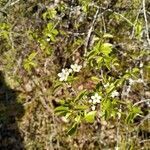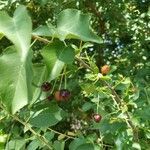Shrubs or trees, not suckering, 30–150 dm, not thorny. Twigs with terminal end buds, densely puberulent. Leaves deciduous; petiole 4–20 mm, glabrous or ± puberulent on adaxial surface, sometimes glandular distally, glands 1–2, ?discoid?; blade broadly ovate, oblong, or suborbiculate, 1.9–4.5 × 1.2–3.4 cm, base usually rounded to truncate, sometimes subcordate, margins crenate, teeth blunt, glandular, apex abruptly acuminate, ?apicula obtuse?, surfaces usually glabrous, sometimes midribs and veins hairy abaxially. Inflorescences 4–10-flowered, corymbs; central axes 8–40 mm. Pedicels 6–18 mm (subtended by leafy bracts), glabrous. Flowers blooming at leaf emergence; hypanthium conic-campanulate, 2–3 mm, glabrous externally; sepals reflexed, oblong, 1.3–2 mm, margins entire, surfaces glabrous; petals white, elliptic to obovate, 6–7 mm; ovaries glabrous. Drupes dark red to black, ovoid, 6–10 mm, glabrous; mesocarps leathery; stones ellipsoid to subglobose, ± flattened. 2n = 16.
Shrub or tree to 10 m, with widely spreading branches; young twigs glandular-puberulent; lvs broadly ovate to orbicular, 3–7 cm, more than half as wide, abruptly short-acuminate, rounded to subcordate at base, finely serrate, the gland near the sinus; corymbs on short, leafy-bracted branches, 4–10-fld, with a distinct axis; pedicels 1–2 cm; cal and hypanthium glabrous; pet white, glabrous, 5–8 mm; fr dark red to black, bitter, 6 mm thick; stone subglobose; 2n=16. Native of Europe, occasionally escaped from cult. in our range.
A spreading deciduous tree. It grows about 12 m high. The leaves are 6 cm long and oval. They have fine teeth around the edge. The leaves are bright green. The flowers are single and white. The fruit is green and 10 mm across. The fruit ripen to black. The kernels are light brown. They are tear shaped and 5 mm long. They are creamy-white inside.
